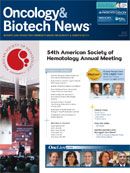Publication
Article
Oncology & Biotech News
Study Supports Chemotherapy-Free Strategy in Acute Promyelocytic Leukemia
Author(s):
A treatment regimen rooted in traditional Chinese philosophy has emerged as a targeted approach for patients with newly diagnosed, lower-risk acute promyelocytic leukemia.
Francesco Lo-Coco, MD
A treatment regimen rooted in traditional Chinese philosophy has emerged as a targeted approach for patients with newly diagnosed, lower-risk acute promyelocytic leukemia (APL) that is at least as effective as the chemotherapy-based standard but without the associated toxicities, according to a leading researcher.
The phase III APL0406 study demonstrated that non—high-risk patients experienced better outcomes through treatment with all-trans-retinoic acid (ATRA) plus arsenic trioxide (ATO) than did those who received simultaneous ATRA and the chemotherapy agent idarubicin (AIDA regimen),1 said lead author Francesco Lo-Coco, MD, professor of Hematology at University Tor Vergata in Rome, Italy.
Lo-Coco discussed the findings during a press briefing and interview at the 54th Annual Meeting of the American Society of Hematology, in Atlanta, Georgia.
The study involved 162 patients, enrolled from October 2007 to September 2010, with a median age of 45.3 years (range, 18.7-70.2 years) and a median white blood cell (WBC) count of 1.50x109/L. (Non—high-risk was defined as WBC ≤10x109/L.) The primary objective was 2-year event-free survival (EFS).
Participants in the ATRA+ATO arm received 45 mg/m2 of ATRA daily plus 0.15/kg of ATO until complete remission, followed by ATRA (2 weeks on and 2 weeks off) for 7 courses and ATO (5 days/ week, 4 weeks on and 4 weeks off, for 4 courses). In the AIDA arm, patients received the standard ATRA plus idarubicin induction followed by three cycles of anthracycline-based plus ATRA consolidation therapy and low-dose chemotherapy plus ATRA for maintenance.
At median follow-up of 31 months, the 2-year EFS for 154 evaluable patients was 97% for the 75 patients in the ATRA+ATO arm (95% CI, 93.1-100) and 86.7% for the 79 participants in the AIDA arm (95% CI, 80.3-93.6). The overall survival rates were 98.7% in the ATRA+ATO arm versus 91.1% in the AIDA arm (P = .03).
Patients treated without chemotherapy experienced fewer episodes of fever and prolonged (>15 day) grade ≥3 neutropenia and thrombocytopenia. The frequency of increased liver enzymes was similar for both groups. Researchers are still analyzing the overall impact on quality of life, including the benefits of fewer hospitalizations not only for patients, but also in terms of medical costs, Lo-Coco said.
Lo-Coco believes the study results may help point the way toward more targeted approaches for other forms of leukemia. “We think it’s a proof of principle and it’s something that should foster research to identify targets of leukemia cells toward which we could use tailored treatments,” he said. “That would mean more specific action, therefore sparing toxicities.”
OncLive TV Exclusive
Dr. Francesco Lo-Coco on Arsenic Trioxide in Acute Promyelocytic Leukemia
William G. Woods, MD, who served as moderator of the press briefing where the APL research was among the featured abstracts, said the findings represent the first curative treatment for APL that does not include myelosuppressive chemotherapy.
“This is a huge step toward frontline use of targeted drugs for acute leukemia,” said Woods, who is director of Pediatric Hematology/Oncology and the Daniel P. Amos Children’s Chair of the Aflac Cancer Center and Blood Disorders Service at Children’s Healthcare of Atlanta.
APL is a relatively uncommon malignancy found in approximately 5% to 15% of acute leukemias diagnosed in the United States.2 It has been linked to a reciprocal translocation between chromosomes 15 and 17, resulting in the fusion of the promyelocytic leukemia (PML) gene and retinoic acid receptor α (RARα).3
Lo-Coco said that APL has evolved from a “highly fatal to highly curable” malignancy, particularly since ATRA was added to chemotherapy for newly diagnosed patients in the early 1990s and ATO became the treatment of choice for relapsed patients a few years later. (He noted, however, that APL can be fatal in a matter of hours or days if not properly diagnosed and treated.)
He said Chinese researchers were inspired by Confucius in developing ATRA, a vitamin A derivative used in their culture as an herbal medicine. The 5thcentury philosopher believed that converting criminals is more effective than punishment in promoting good behavior, Lo-Coco said, and researchers followed similar reasoning with cancer cells.
“They succeeded in transforming malignant cells— [which are] the result of a differentiation block—into ‘good guys,’” said Lo-Coco, calling the result a “revolutionary” finding.
Molecular analysis has since established that ATRA converts malignant APL cells into “terminally differentiated cells that eventually died physiologically,” Lo-Coco said.
He said ATO, also a traditional Chinese medicine, induces apoptosis, or cell death.
Although Chinese investigators were pursuing natural compounds based initially on empirical knowledge, Lo-Coco said research has subsequently shown that the altered protein in APL cells has specific binding sites for both ATRA and ATO.
He said researchers must focus on improving their understanding of the mechanisms of other forms of leukemia, and that he hopes this study will promote further exploration.
The APL0406 study was conducted by the Italian- German cooperative teams Gruppo Italiano Malattie EMatologiche dell'Adulto (GIMEMA), Study Alliance Leukemia (SAL) group, and German-Austrian AML Study Group (AMSLG).
References
- Lo-Coco F, Avvisati G, Orlando SM, et al. ATRA and arsenic trioxide versus ATRA and idarubicin for newly diagnosed, non high-risk acute promyelocytic leukemia: results of the phase III, prospective, randomized, intergroup APL0406 Study by the Italian-German Cooperative Groups Gimema-SAL-AMLSG. Blood. (ASH Annual Meeting Abstracts). 2012;120(21): abstr 6.
- Ravandi F. Current treatment options for acute promyelocytic leukemia. Clinical Care Options website. Available at: http://goo.gl/y7sAN. Published January 18, 2013. Accessed January 29, 2013.
- Wang Z-Y, Chen Z. Acute promyelocytic leukemia: from highly fatal to highly curable. Blood. 2008;111(5): 2505-2515.










